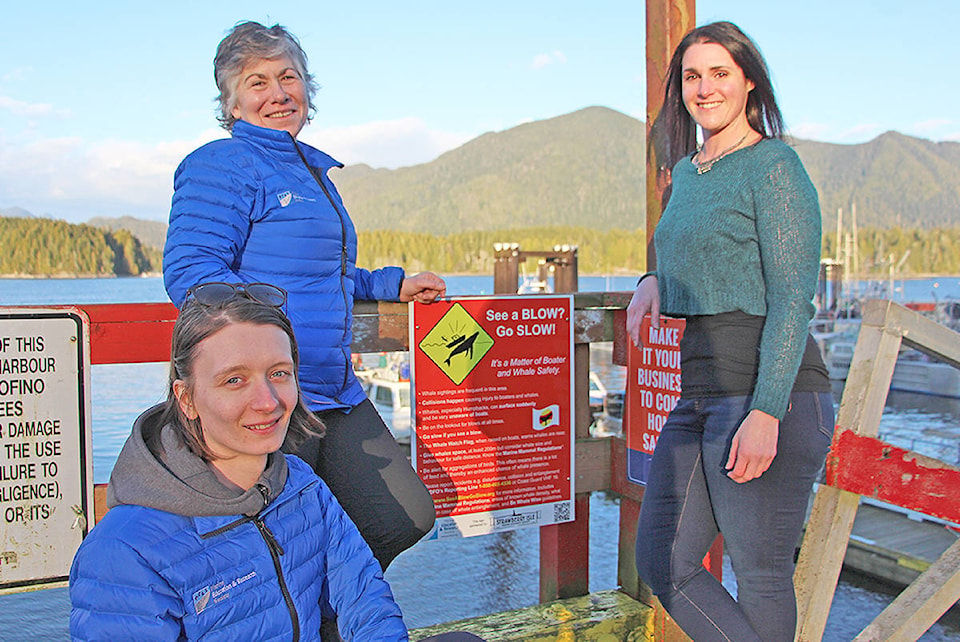‘See a blow? Go slow!’
That’s the slogan behind an educational campaign developed by the Marine Education and Research Society to prevent potentially catastrophic collisions by boosting boater awareness of the whales surrounding them.
MERS’ education and communications coordinator Jackie Hildering told the Westerly News that B.C.’s once dwindling humpback whale population is surging on the West Coast—rising from seven individuals in 2003 to 86 in 2018—creating a hazardous minefield in local waters.
“I am extraordinarily privileged in having seen the increase of humpbacks on our coast but, with that comes the reality that humpbacks are a game changer for boaters on our coast and as brilliant as it is that they are back as they are, there is not the public awareness around what it means to have humpbacks back in our waters,” she said. “In an ideal world we would be able to set up the equivalent of ‘elk crossing’ signs, but that’s very difficult with a marine species.”
She added that humpbacks move differently than the orcas and grey whales that boaters are used to and that collisions can have serious impacts, citing a recent incident where a boater was paralyzed after a crash with a humpback.
“They are, of course, huge and they do not have biosonar as do toothed whales like orca. They are extremely acrobatic and they are most often not going in one direction. Boaters have to be alert on our coast to the fact that they could pop up almost anywhere,” she said. “It is like running a gauntlet now in many areas of our coast where you have to be vigilant all the time. One would assume that boaters would be like that, but we have found out that this is not the case and that they criss-cross as if nothing would suddenly surface…There’s such a lack of awareness about the number of humpbacks back on our coast that boaters are putting themselves at risk.”
Hildering was on the West Coast to deliver two presentations on whales that were co-hosted by Cedar Coast Field Station and the Tofino Resort and Marina.
She was speaking to the Westerly News from Tofino’s Fourth Street Dock where she was delighted to join the Strawberry Isle Marine Research Society’s executive director Michelle Segal to celebrate the installation of a new educational sign promoting safe boating. MERS has helped install roughly 130 such signs and hopes to have one installed at every dock, harbour and boat ramp on Vancouver Island.
The signs are supplemented by online resources available at www.seeablowgoslow.org.
Hildering added the campaign also includes information around what boaters should do if they come upon an entangled whale.
“We’re desperately trying to educate people that most often if you cut lines at the surface you are cursing the whale because the whale could still be entangled under the surface,” she said.
“Our research, looking at scars on the whales, is that 50 per cent of the humpbacks in B.C. waters have been entangled at some point…This is a huge eye opener about how serious a threat this actually is and of course that’s not capturing how many of them become entangled, die and sink to the bottom of the ocean.”
Segal said Strawberry Isle. was happy to partner with MERS to install the new sign at Tofino’s harbour and added that it includes important information about boaters being mandated by federal law to report all collisions and entanglements they witness to the Department of Fisheries and Oceans Canada at 1-800-465-4336.
“It’s really crucial that we have a network of people who live on our coast and know these waters well to report any incidents that they see to that DFO hotline,” Segal said. “The ultimate goal of these signs is that every resident in this town will have that number programmed into their phone and know exactly who to call when they see a violation, when they see an entanglement, when they see a distressed animal and then we can have an appropriate response to that incident.”
Both MERS and SIMRS are members of the British Columbia Marine Mammal Response Network, an advisory panel mandated to protect marine mammals and respond to incidents and Segal said information from local boaters is vital to the network’s efforts.
“The marine community here are the eyes and ears on the water and we rely on them to be self governing a lot of the time, to prop each other up, to help each other in situations and that includes incidents with marine mammals,” she said. “Luckily, this community is full of really knowledgeable and caring people. That’s a gift and we need to use it as a resource to respond to these incidents…It’s an ecosystem approach to empathy and we’re trying to avoid apathy here.”
READ MORE: DFO declares Swiftsure and LaPerouse Banks critical habitats for killer whales
READ MORE: Humpback whale that washed up near Ucluelet had broken jaw
READ MORE: Sea lion shot in Ucluelet euthanized at Vancouver Aquarium
andrew.bailey@westerlynews.ca
Like us on Facebook and follow us on Twitter
